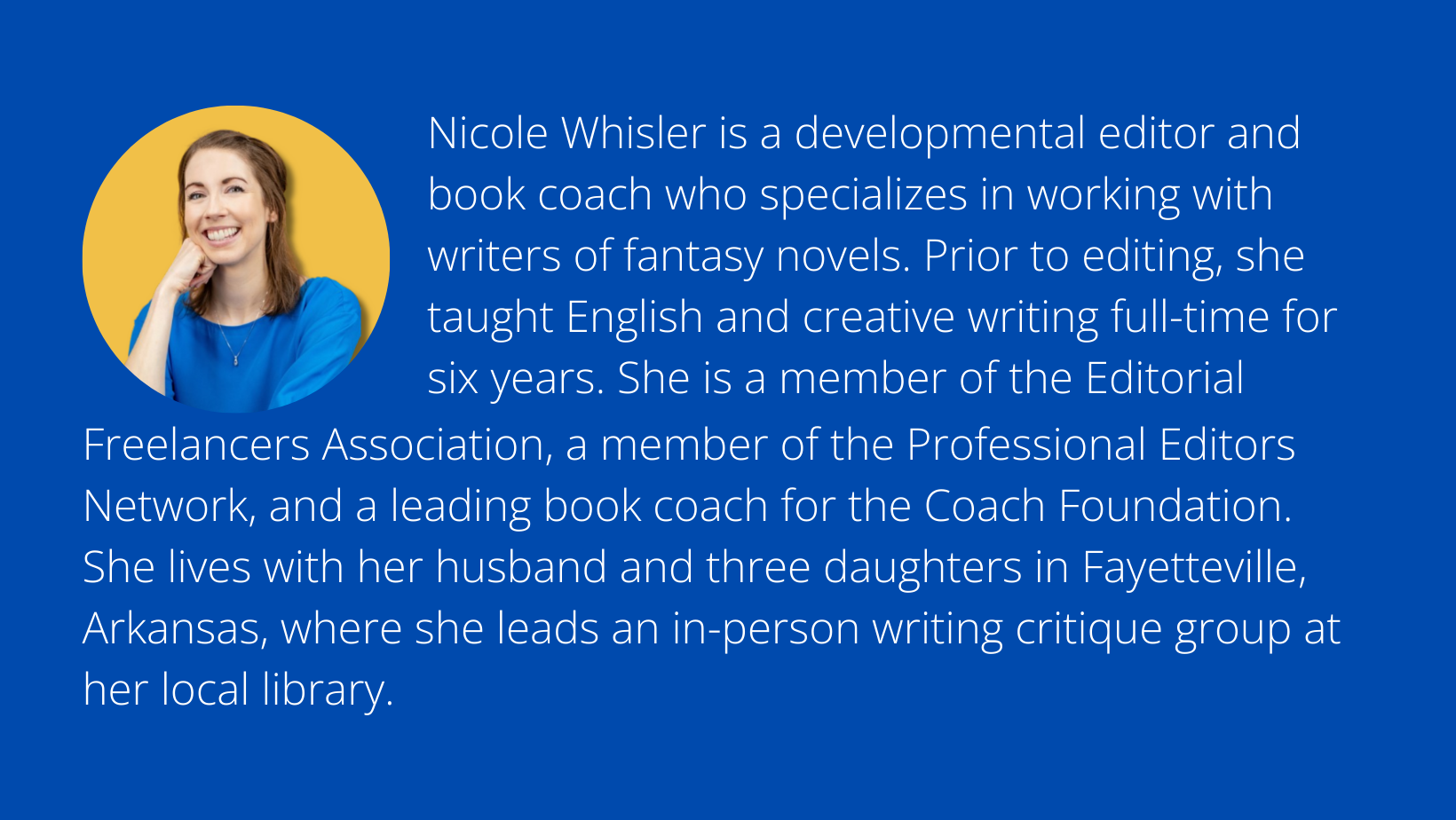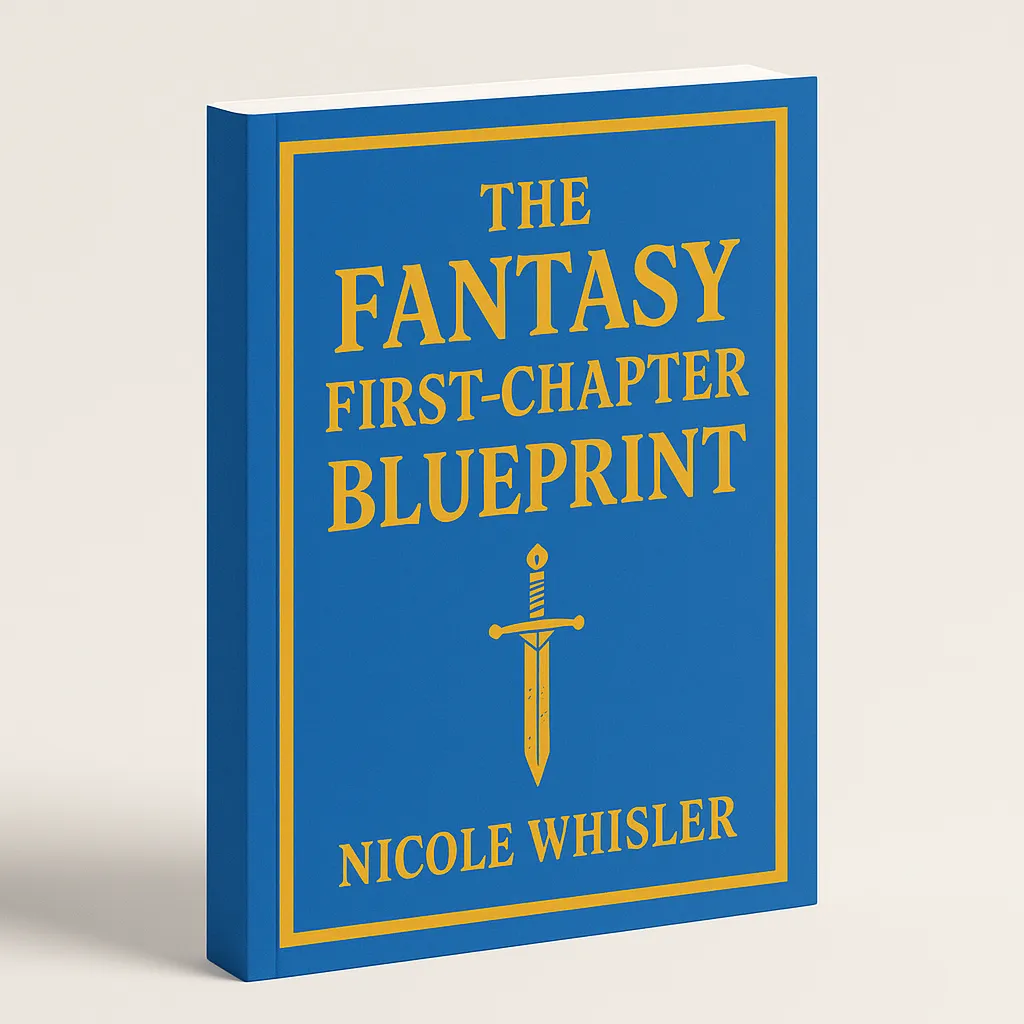The Fantasy First-Chapter Blueprint
Your first chapter is your one shot to hook an agent or a reader. Don't let the 7 deadliest mistakes land your manuscript in the rejection pile. This free 7-day email course gives you the step-by-step blueprint to avoid them and craft an irresistible opening.

Your Novel Matters ...
Looking for the right book coach for your fantasy novel?
Are you a fantasy writer …
… struggling to convert the vivid scenes of your fantasy novel from your imagination to the page?
… stuck in a loop where you constantly rewrite your opening pages?
… worried your story won’t resonate with your readers?
What if I could show you the exact steps week to week that would take you from brainstorming and drafting to revising and publication?
I specialize in developmental editing and book coaching for writers of fantasy novels—writers who value the craft of storytelling and wish to create stories that resonate.
My Services
Develop Your Ideas
Fantasy Footsteps: Road to Publication

I’ll let you in on a secret. All you need to succeed as a writer are three things:
A Roadmap: Illuminate your path with a step-by-step guide, ensuring you achieve your writing goals every week. From outlining to publishing, every stage of your journey is mapped out for success.
Mindset Mastery: Learn how your thoughts control your outcomes in your writing. Overcome self-doubt and unearth the confidence that will bring your unique ideas to life on the page.
Personalized Support: Prepare for comprehensive assistance, real-time accountability, and feedback tailored to your needs. From brainstorming sessions to final publication, you'll have a dedicated ally guiding you every step of the way.
With these three pillars, you'll unlock the potential to:
Craft a captivating story that enthralls readers from the first page to the last.
Develop complex characters and immersive worlds that resonate deeply with your audience.
Navigate the complexities of plot twists and pacing, keeping readers hooked until the final chapter.
Receive specific guidance on refining your scenes so that readers root for your protagonist.
Overcome writer's block and stay motivated throughout your writing journey, ensuring consistent progress.
Transform your rough draft into a polished, professional manuscript ready for publication.
Are you ready to turn your fantasy novel from a mere vision into a masterpiece that captures hearts and minds?
Join Fantasy Footsteps: Road to Publication and begin your author journey with everything you need to write a story that works.
Don't let your story remain trapped in your mind—bring it to life with me!
If you’re thinking, “Yes, please! Tell me what to do!” , I’d like to invite you to work one-to-one with me to finish your novel and write a story that works. Join my book coaching program designed specifically for fantasy writers—Fantasy Footsteps: Road to Publication.

Discover Helpful Tools
Resources For Writers
Here you will find some of my favorite resources for writers.
Add these books, podcasts, websites, and other resources to your writing toolbox to augment your writing at any stage.
Join My Free, Private Facebook Group
Finish My Fantasy Novel: Write & Revise My Best Book in 6 Months
In the group, I go live weekly with writing tips. The group is also a platform for writers to support each other and share their wins and progress.
Live training schedule:
1st Tuesday of the month: Free critique for someone in the group!
2nd Tuesday of the month: Writing sprint with fellow writers
3rd Tuesday of the month: Live training on a specific topic
4th Tuesday of the month: Interview with an author or marketing/business expert


Improve Your Craft
Writing Advice Blog
As a developmental editor and book coach, everything I post is designed to help you build your creativity, strengthen your prose, and explore new avenues in your writing. The opinions in each post are my own, but many are inspired by ideas from established authors and editors who excel in their fields.
Rely on my blog for clear and specific writing advice, motivational tips and grammatical aid, and interviews with experts!
Hi! I'm Nicole.
I’m a Developmental
Editor & Book Coach for Fantasy Writers.
Like you, I'm a writer. I understand the mental and emotional ups and downs of storytelling. Don't let resistance win! Recognize the value of good advice plus hard work.
My approach to novel writing is multifaceted. For a deeper understanding of my process and style, take a look at some of my favorite craft-of-writing books in my Resources section.
What can I say about myself? I read, I write, I read about writing, and I write about reading. It never gets old to me.

See what writers like you are saying . . .

Nadir Shirazi
“I’ve been stalling on my Islam-inspired sci-fantasy series for 10 years. But within 10 minutes of starting Nicole’s program, I started writing again."

Amanda Emerick
“I can’t recommend Fantasy Footsteps enough to writers who are legitimately looking to polish their craft, write, and eventually publish their novel."

Trinity Cunningham
“I loved discussing my story with Nicole. She provided me with invaluable insights I never would have considered on my own."
Latest on the Blog

You will find no pictures of kittens here. No images of favorite dessert recipes, snapshots of my recent vacations, videos of puppies playing the piano (although I do love dogs), or YouTube clips of monkeys stealing people’s sunglasses.
I’m genuinely sorry if that disappoints you.
Instead, you can rely on my blog for clear and specific writing advice, motivational tips, grammatical aid, and author/editor interviews.
As a developmental editor & book coach, everything I post is designed to help you build your creativity, strengthen your prose, and explore new avenues in your writing. The opinions in each post are my own, but many are inspired by ideas from established authors and editors who excel in their fields.
Some of these tips might be just what you need to hear. Others might not work for you personally, and that’s okay.
Apply the tips that fit your personality and writing habits, and feel free to adapt or ignore the others. For further questions and comments, you can email me or reach me through my Contact page.

Erasing White Room Syndrome from Your Scenes
Discover in this post …
how to tell if your novel contains White Room Syndrome.
what happens in readers' minds when your scenes lack atmosphere.
two simple fixes to eliminate White Room Syndrome from your novel.
Where's the Atmosphere?
Have you ever read a book that contains realistic characters, a plot that moves steadily forward, but little to no detail about your characters' surroundings?
Maybe there's a heavy amount of dialogue on the page but not much else.
Or maybe the scenes take place largely in your protagonist's mind—and although readers know exactly what your character is thinking, that's all they know.
It's as if your characters are in a vast white room, interacting with others (or with themselves) but not interacting with the environment.
This issue is known as White Room Syndrome, and it can keep readers from fully immersing themselves in our story. As writers, we have the incredible opportunity to connect deeply with our target audience, but when readers can't picture how the environment ties into a particular scene, they often feel distanced from the story itself.
Don't worry if this describes you! This issue is easy to identify and fairly easy to resolve. I'm about to discuss two simple ways to eliminate White Room Syndrome from your scenes so that your story resonates with readers as you intended.
But first, ask yourself an important question:
First Things First
The first step toward erasing White Room Syndrome from your scenes is to ask yourself, "To what extent is my setting missing?" I've known many writers who provide a brief setting description early in each scene, then go hundreds (sometimes thousands!) of words without mentioning it again or its impact on the characters.
Again, this can be problematic if your goal is to immerse readers in your story. Readers who can't "see" your story in their mind as it unfolds may lose interest and close your book. So first, determine the extent of the issue. If all your scenes lack atmosphere and environment, you've got your work cut out for you, but it's still fixable. And if it's a more minor issue, note the specific conversations or problematic moments and attack them one by one.
Now let's dive into two simple methods to eliminate White Room Syndrome from your novel!
Method #1: The 5 Senses

You may have heard the advice "Consider the five senses as you write." It's solid advice, but I'd add something to it:
Consider the five senses in terms of your point-of-view character. In other words, what does your point-of-view character notice about their environment?
I had a recent conversation with a writer trying to overcome White Room Syndrome in her novel. She recognized that it was a problem, telling me she knew talking heads in a vague room wasn't good and that she was trying to get better at adding small details to the story.
To pinpoint her exact difficulty, I asked her for further clarification, and she told me, "I can imagine the room very well when there's something special about it, but when it's just a kitchen, it's hard to see something worth mentioning."
We chatted a bit more, and she thanked me, saying, "By making me voice the problem, you helped me find a solution. The solution is to think not about what in the room is interesting to me, but what is interesting to the character. In the case of the kitchen in the chapter I'm editing now, it's in an old house, so it should be full of old furniture. My main character loves old stuff, so ... why not let her admire it a little?"
If you're writing in close first- or third-person point of view, always consider what your character would naturally be thinking in that moment.
For example, a teenager who's focused on his recent argument with his girlfriend isn't likely to notice the bright blue paint on his kitchen walls—unless the paint is peeling and the color is fading, and he asks himself why everything in his life falls into ruin. Or perhaps he doesn't realize this consciously, but his eye catches the peeling paint and readers fill in the rest on their own.
As the writer above noted, you are not identical to your protagonist. The sights, smells, and sounds you'd naturally notice in any given situation will differ from what your protagonist notices. Build a picture for readers around your point-of-view character's natural observations of their setting, and you'll add realism to your scenes.
Method #2: Character Reaction

The second way to rid your scenes of the dreaded White Room Syndrome also relates to your point-of-view character, but it goes deeper. Whereas in Method #1, I discussed how to know which missing sensory details to fill in, Method #2 is about highlighting not just what your character notices, but what that particular detail means to them.
This tactic will prevent you from accidentally adding lengthy blocks of dialogue with little else on the page. Train yourself to think, "How does my character react to what's happening on the page? How do they feel about it? What do they think about it?", and you'll become well-versed in revealing your character's inner world, which in turn will foster a stronger connection between your character and readers.
It's easy for your novel to become a "play by play" in which you describe what happens on the page, or a "he said/she said" in which readers get nothing but speech bubbles, but in doing so, we often diminish or hide the point-of-view character's emotions. (Don't get me wrong—there are times when rapid-fire dialogue works beautifully, but it should be used on purpose to create a certain effect, not used because we don't know how to fill in the gaps.)
I was guilty of lacking character emotion on the page years ago. I remember submitting an opening chapter to my critique group in Jefferson City, Missouri. One of the critique members commented on my scene, saying, "I could use a little more from your main character."
This was actually great feedback, but at the time, I wasn't sure how to incorporate it. I even followed up with that commenter after the critique session, asking her to clarify what she meant. She wasn't an editor or a book coach, so although she did her best to explain, I wasn't confident I'd fully resolved the problem once I implemented my desired changes.
Now, after reading hundreds of scenes from my clients, I know exactly what she meant and how to fix it.
I thought at the time that readers were feeling all the emotions along with my protagonist. I knew how she was feeling, so I assumed they would know as well. But they didn't! Until I dove into my protagonist's head on the page and showed her relevant thoughts, feelings, and emotions, readers had to use guesswork to draw conclusions about my protagonist.
And while some guesswork is fine, if the pieces are absent altogether, you're likely missing out on a key opportunity to establish and strengthen that all-important character–reader connection.
But that's what writing is all about—learning, experimenting, and growing!
For further explanations and examples related to this topic, take a look at my prior blog posts on character reaction and character voice.
Summing Up
Today I’ve examined two ways to rid your novel of White Room Syndrome:
Determine what your point-of-view character would naturally notice about their surroundings in any given scene. This will vary from character to character.
Include on the page not just the what, but the why. Give readers a sense of not only what stands out to your character, but what it means to them and why it's important to their story and/or character arc.
If you find yourself thinking, "What can I possibly include in this scene to make sure it's not too bare for readers?", you may be asking the wrong question. Ask yourself a slight variation: "What does my character notice about the atmosphere and environment in this scene, and what does it mean to them?" to help your story grow deeper and more immersive.
Do you see elements of White Room Syndrome in your own work? Or are you fantastic at balancing your plot, dialogue, setting, and character reactions? I'd love for you to share your thoughts with me by emailing me at [email protected], and if you gained value from this content, I'd love for you to share it with others!
Do you want to learn how to write a story that makes your target readers stand up and cheer? If you’d like support from A to Z (from brainstorming to drafting to revising to publication), book a Discovery Call with me to see if you’re a good fit to join my book coaching program, Fantasy Footsteps: Road to Publication. And if you haven’t done so already, grab your Free Guide on how to hook readers from your story’s start!

Capture Your Readers from Your First Scene
Get my exclusive blueprint—7 Mistakes to Avoid in Your Fantasy Novel’s Opening. Start your fantasy novel right!
Are you worried you've failed to establish a bond between readers and characters in your first chapter? Do you wonder if you've bogged readers down with your worldbuilding? Do you sometimes overlook essential conflicts? Many readers will put your book down if it doesn't grab their attention right away, so it's vital to evoke powerful emotions from readers as early as possible.
Don't let these common mistakes rob your story of its magic and momentum. Save your precious time and energy by ensuring you hook readers from the start. Grab your guide now and check your opening against these common missteps!
(You will also receive monthly writing advice, updates about my free live trainings, and direct access to replays. Unsubscribe anytime.)

